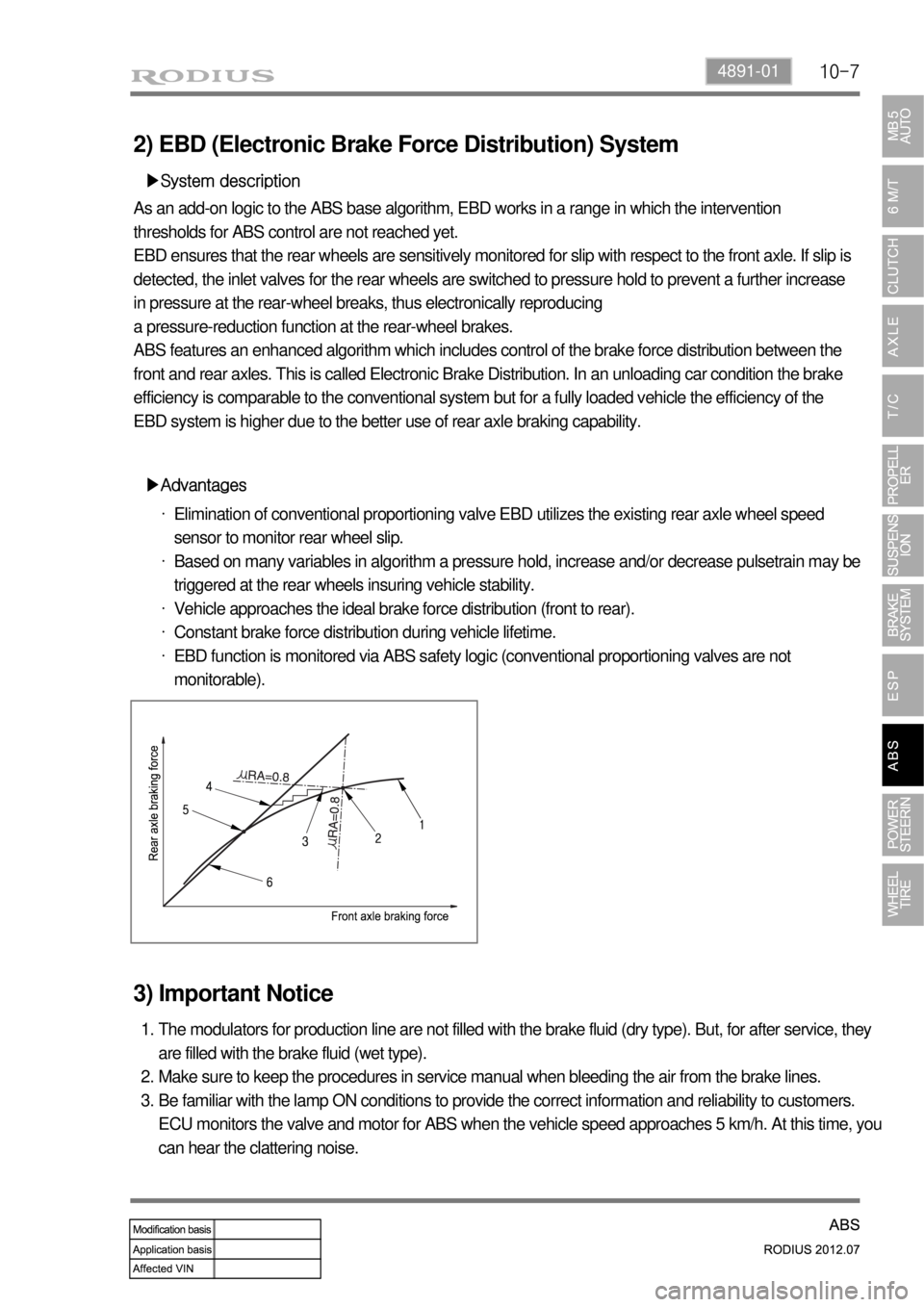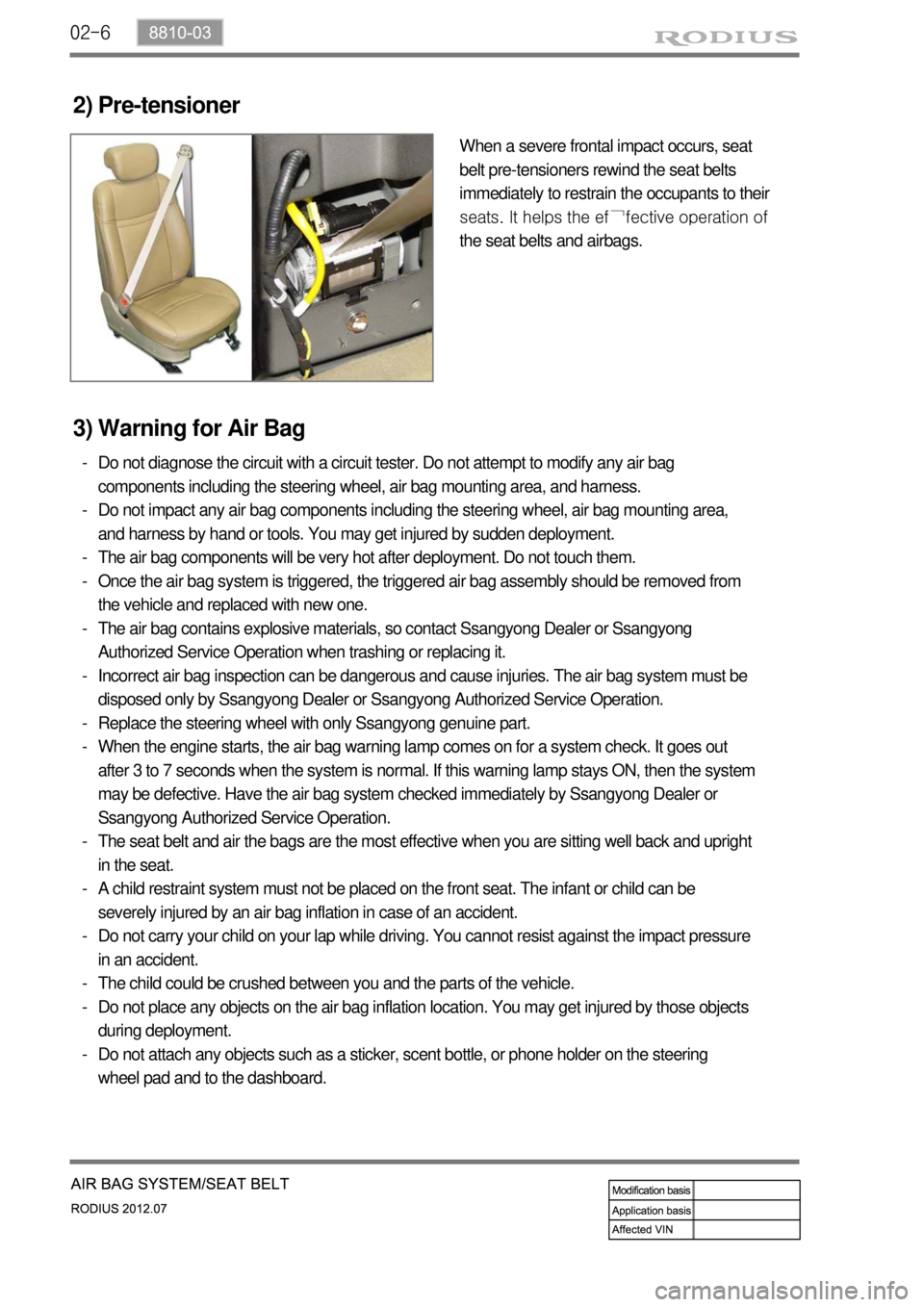service SSANGYONG RODIUS 2012 Owner's Manual
[x] Cancel search | Manufacturer: SSANGYONG, Model Year: 2012, Model line: RODIUS, Model: SSANGYONG RODIUS 2012Pages: 715, PDF Size: 79.36 MB
Page 583 of 715

06-4
Part Number/Part Name Description
116 589 09 43 00 (P 99 48 003
0A) InstallerTo install the center bearing
129 589 00 34 00 (P 99 33 002
0B) Pulling armTo remove the center bearing
2. SPECIAL SERVICE TOOL
Page 594 of 715

08-34850-03
Brake oil Grade DOT 4
Service interval Replace every 2 years
1. SPECIFICATIONS
Description Specification
Front brake Type Ventilated disc
Rear brake Type Ventilated disc
Master cylinder Type Step feed bore tandem, double cylinder
Brake booster Type Tandem type(integrated level sensor)
Operating type Foot operated type
Page 595 of 715

08-4
2. SPECIAL SERVICE TOOL
Piston Puller Caliper Piston Compressor
Page 636 of 715

10-74891-01
2) EBD (Electronic Brake Force Distribution) System
▶System description
As an add-on logic to the ABS base algorithm, EBD works in a range in which the intervention
thresholds for ABS control are not reached yet.
EBD ensures that the rear wheels are sensitively monitored for slip with respect to the front axle. If slip is
detected, the inlet valves for the rear wheels are switched to pressure hold to prevent a further increase
in pressure at the rear-wheel breaks, thus electronically reproducing
a pressure-reduction function at the rear-wheel brakes.
ABS features an enhanced algorithm which includes control of the brake force distribution between the
front and rear axles. This is called Electronic Brake Distribution. In an unloading car condition the brake
efficiency is comparable to the conventional system but for a fully loaded vehicle the efficiency of the
EBD system is higher due to the better use of rear axle braking capability.
▶Advantages
Elimination of conventional proportioning valve EBD utilizes the existing rear axle wheel speed
sensor to monitor rear wheel slip.
Based on many variables in algorithm a pressure hold, increase and/or decrease pulsetrain may be
triggered at the rear wheels insuring vehicle stability.
Vehicle approaches the ideal brake force distribution (front to rear).
Constant brake force distribution during vehicle lifetime.
EBD function is monitored via ABS safety logic (conventional proportioning valves are not
monitorable). ·
·
·
·
·
3) Important Notice
The modulators for production line are not filled with the brake fluid (dry type). But, for after service, they
are filled with the brake fluid (wet type).
Make sure to keep the procedures in service manual when bleeding the air from the brake lines.
Be familiar with the lamp ON conditions to provide the correct information and reliability to customers.
ECU monitors the valve and motor for ABS when the vehicle speed approaches 5 km/h. At this time, you
can hear the clattering noise. 1.
2.
3.
Page 648 of 715

11-10
Oil Pump Pressure Check ▶
Check the oil pump pressure to locate any defect
in oil pump.
Before checking the pressure, check the oil
level and belt tension. Prepare the empty
container to collect the spilled oil during the
service.
Unscrew the pressure line fitting in power
steering pump.
Install the pressure gauge between the
power steering pump and the power steering
oil pressure line.
Place the shift lever to neutral position. Apply
the parking brake.
Open the valve in pressure gauge. Start the
engine and let it run at idle speed.
Turn the steering wheel several times so that
the oil temperature reaches to normal
operating level. A.
B.
C.
D.
E.
Fully close the valve in pressure gauge and
measure the oil pressure. F.
To prevent internal damage, do not close the
gauge valve over 10 seconds.
Keep the oil temperature at proper range. -
-
Relief pressure90 ± 3 bar
Page 674 of 715

02-6
When a severe frontal impact occurs, seat
belt pre-tensioners rewind the seat belts
immediately to restrain the occupants to their
seats. It helps the ef¬fective operation of
the seat belts and airbags.
2) Pre-tensioner
3) Warning for Air Bag
Do not diagnose the circuit with a circuit tester. Do not attempt to modify any air bag
components including the steering wheel, air bag mounting area, and harness.
Do not impact any air bag components including the steering wheel, air bag mounting area,
and harness by hand or tools. You may get injured by sudden deployment.
The air bag components will be very hot after deployment. Do not touch them.
Once the air bag system is triggered, the triggered air bag assembly should be removed from
the vehicle and replaced with new one.
The air bag contains explosive materials, so contact Ssangyong Dealer or Ssangyong
Authorized Service Operation when trashing or replacing it.
Incorrect air bag inspection can be dangerous and cause injuries. The air bag system must be
disposed only by Ssangyong Dealer or Ssangyong Authorized Service Operation.
Replace the steering wheel with only Ssangyong genuine part.
When the engine starts, the air bag warning lamp comes on for a system check. It goes out
after 3 to 7 seconds when the system is normal. If this warning lamp stays ON, then the system
may be defective. Have the air bag system checked immediately by Ssangyong Dealer or
Ssangyong Authorized Service Operation.
The seat belt and air the bags are the most effective when you are sitting well back and upright
in the seat.
A child restraint system must not be placed on the front seat. The infant or child can be
severely injured by an air bag inflation in case of an accident.
Do not carry your child on your lap while driving. You cannot resist against the impact pressure
in an accident.
The child could be crushed between you and the parts of the vehicle.
Do not place any objects on the air bag inflation location. You may get injured by those objects
during deployment.
Do not attach any objects such as a sticker, scent bottle, or phone holder on the steering
wheel pad and to the dashboard. -
-
-
-
-
-
-
-
-
-
-
-
-
-
Page 675 of 715

02-78810-03
Do not put the seat cover on the front seatbacks. It may interfere with the side air bag inflation.
When sitting in the rear seat, do not hold onto the seatback of the front seat. If the side air bag
inflates, the occupant may get seriously injured.
Do not lean on the door. When the side air bag inflates, the occupant may get seriously injured.
Do not place any objects such as an umbrella or a bag between the side air bag and the door.
Do not place the part of your body near the side air bag. You may obstruct the side air bag or
get injured by the inflation impact.
Do not slam the front doors. It may lead to an unintended inflation of the side air bag.
Do not move your seat too close to the steering wheel or dashboard. If you lower your head,
the air bag can hit your head during inflation and can cause severe injury or even death.
Hold only the outer rim of the steering so that the air bag can inflate without any hindrances.
Do not place your face or chest near the steering wheel and dashboard. Also, do not allow
anyone to place their hands, leg or face on the dashboard. The air bag cannot work properly.
Do not hold and operate the steering wheel by crossing your arms. You could get seriously
injured when the air bag deploys.
When the air bag inflates, it makes a loud noise and smoke. However, the smoke is a non-
toxic nitrogen gas.
When the air bag is deployed, non-toxic gas will come out. This gas may cause skin, eyes or
nose irritation.
Wash it out with cold and clean water and consult the doctor if irritation continues.
When any repairs are needed for the steering wheel, or when an accident occurred without the
air bag deployment, have the air bag system checked by Ssangyong Dealer or Ssangyong
Authorized Service Operation.
The windshield glass may be broken when the passenger's air bag is deployed.
The air bag deployment can cause abrasion on your hands and face. -
-
-
-
-
-
-
-
-
-
-
-
-
-
-
-
4) Major Replacement Parts after Air Bag Deployment
In Case Of Front Air Bag Deployment ▶
Instrument panel, deployed air bag module, air bag unit, seat belt pre-tensioner, wirings
(including connectors), damaged trim and components
In Case Of Curtain Air Bag Deployment ▶
Deployed side bag, air bag unit, side air bag sensor, wirings (including connectors), damaged
trim and seat components